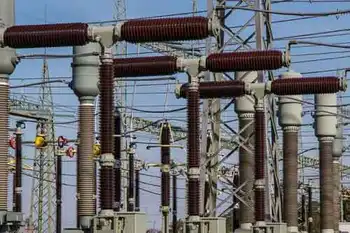Grid gets smart
By Ottawa Citizen
Protective Relay Training - Basic
Our customized live online or in‑person group training can be delivered to your staff at your location.

- Live Online
- 12 hours Instructor-led
- Group Training Available
Today, the meter readers have been replaced by a network of "smart meters" that send in electricity readings automatically and can alert authorities when a marijuana grow-op tries to tap illegally into the power supply.
Soon, this network will do much more. As the first step toward the creation of a more sophisticated energy grid — or "smart grid" — it will be capable of diagnosing problems before they happen. It will turn down air conditioners in a particular city or region during electricity shortages, and monitor the exact electrical use of each home it services.
"Pretty much all customers are now sitting with a smart meter and the smart meters are now all talking to each other through a wireless network," says Norm Fraser, chief operating officer of Hydro Ottawa.
"The meters are all communicating with each other and we communicate with them. We can interrogate the meter to find out the usage. There are no more estimated bills — they are all accurate."
In coming weeks, new computer technology at various points in the Hydro Ottawa network will help it monitor electrical transmissions and report the second those transmissions are disrupted.
"We will be able to pin-point the problem, whether a tree is rubbing on a wire or a wire is down," says Fraser. "Ten years ago we had no idea when customers were going without power. They would phone us and then we would go and fix them.
"Devices are now being deployed, and have been in some areas of Ottawa, where we will be able to determine the power is out immediately and then dispatch crews, possibly before the customer is aware of it."
With more than 285,000 meters in place, Ottawa is at the forefront of smart-grid technology. In September, Hydro Ottawa was awarded with the 2008 Best Advanced Metering Initiative Award for North America from the Utility Planning Network — an international lobby group made up of electricity producers.
But the rest of the world is quickly catching up in the drive to create an electrical grid that will give users complete control over how much energy they are using, when they use it, and will even allow them to sell excess electricity back to their utility.
The biggest problem facing electrical customers everywhere is a lack of information. Short of going outside to peer at the dials on their conventional meters, customers have no idea how much power they are actually using until the bill comes at the end of the month. If that bill has been estimated, it could be several months before they discover how much electricity they have consumed.
The current system does little to encourage consumers to conserve electricity, and in turn hampers a utility's efforts to become more environmentally sensitive.
And with the world's appetite for electricity expected to double to 33.3 trillion kilowatt-hours in 2030 from 17.3 trillion kw/h in 2005, according to estimates from the U.S. Energy Information Administration, the pressure for a more efficient approach will only increase.
"This is being done for the consumers," says Don Tench, director of market evolution at Ontario's Independent Electricity System Operator, the organization responsible for monitoring Ontario's energy supply.
"People are calling for a change of focus to the electricity industry to make it more renewable and reduce the environmental footprint."
The global push towards a more responsible, responsive grid is seeing electrical systems everywhere undergo the first major upgrade since their creation more than 50 years ago.
The United States government has recently committed $3.4 billion [US] to a Smart Grid Investment Program that will see the electrical system in the U.S. upgraded to include smart meters and other communications technology. Some observers have claimed it will cost the U.S. as much as $450 billion [US] to prepare its electrical grid for the changes expected over the next decade.
In Canada, the federal government has set up a $191-million fund to spur development of smart grid projects. The Ontario government is offering $10 million a year, over the next five years, to help local distributors like Hydro Ottawa test new "smart" electricity technologies. More funding announcements are expected within the coming months.
All Canadian provinces are moving toward smart grids, but Ontario is in the lead. In November 2005, the province passed legislation making it mandatory for all of Ontario's electricity suppliers to install smart meters on every home by 2010.
Smart meters now are in place in about two million homes and small businesses in Ontario. But utilities need to install around 2.7 million more by next year to meet the province's goal.
Globally, reports have suggested as many as 76 million smart meters have been installed to date. That number will jump to more than 155 million by 2013.
"You can almost call it a revolution going on here in Ontario and throughout much of the world," says Tench. "Some people are calling this the third industrial revolution and saying the energy system needs to go through a major redesign. Smart grid is a major part of that."
A key goal is to create an energy grid that will more easily support home-grown sources of electricity, as more people opt to generate power through solar panels or small wind turbines.
"The minister has said he expects 100,000 rooftop photovoltaic (solar) installations in the next three years," says Fraser. "If you translate that on a percentage basis to the City of Ottawa, that would mean 5,000 to 6,000 here alone."
Add to that numerous new large-scale renewable energy installations, such as a windfarm proposed for North Gower and a huge solar farm being readied in West Carleton, and today's electrical system simply won't be adequate.
The electrical grid was designed as a one-way street. People pulled as much juice off their system as they needed. With new forms of generation coming online, the need now is for a two-lane highway. The grid must be capable of sending and receiving electrical signals from thousands, if not millions, of small renewable electrical generating stations.
New generations of hybrid gas-electric cars promise to be a major part of this approach.
Like current hybrids, vehicles such as the soon-to-be-released Chevrolet Volt generate electricity while being driven by capturing energy that would otherwise be lost through braking. But because the Volt is designed to be plugged in to an electricity outlet, owners will be able to dump excess electricity, such as a partially charged battery, onto the grid once they get home.
Wind or solar farms could use smart grid technologies to send power to electric cars specifically. The fickle nature of these types of energy generation means they are not producing electricity 100 per cent of the time. Dumping their production into car batteries would see the automobiles become a type of temporary electrical storage device. Excess energy collected from the renewable source could then be returned to the grid when the car discharges its battery.
"The notion of the smart grid in the future is that customers become part of the interplay," says Fraser. "They will be able to determine when they want to use power, when they want to shut systems down and maybe they will want to generate their own electricity."
Smart meters will allow utilities to enact long-anticipated "time-of-use" pricing, in which electricity costs more during peak hours, encouraging consumers to choose to delay activities requiring large amounts of electricity until off-peak times. It will also allow the utilities to shut off or turn down appliances in homes when a power shortage is looming.
Time-of-use pricing is being tested in Toronto and plans for municipalities are expected to be announced soon.
Smart meters will also work with a new breed of consumer electrical devices being built to take advantage of smart grid technologies.
"There are devices that are going to be coming out in rapid succession over the next few years. Things like smart fridges and freezers, appliances, thermostat controls and pool pumps. Things that will be controllable through the Internet or arrangements with a retailer," Fraser says.
"A customer could say, I never want my pool pump to operate between the hours of 4 p.m. and 8 p.m. because that's when the peak price occurs. The device will know how to do that."
Consumers won't have to wait long for these devices. Appliance makers GE and Whirlpool, for example, have announced they will be releasing appliances capable of communicating with a smart meter next year. Owners will be able to set their washing machine to come on only when electricity rates drop below a certain price, preventing high-load activities from being done during peak energy times.
Natural gas and electricity distributor Direct Energy announced it has signed a deal with a company called e-Radio U.S.A. Inc. to use FM radio frequencies to speak with smart meters and order them to shut down air conditioners or alter certain thermostats when needed to reduce the load on the grid.
The company is testing its FM radio technology in Ontario, California and Texas.
Google has released an application that allows Toronto Hydro customers to monitor the energy consumption of their home remotely over the Internet, using their smart meter.
And Microsoft's soon-to-be-released Hohm software program will help homeowners monitor and lower their energy consumption.
"Once you see these big players who know how to mass-market information that is of value to the general public, then you start to see people taking much more interest in this area," says Tench. "We are going to see more."
The Ontario Smart Grid Forum released a report called Enabling Tomorrow's Electricity System in February. The document aims to serve as a road map about how to implement Ontario's smart grid.
As for the ever-walking meter readers, who worked on contract for Hydro Ottawa, well, they've moved on. Some have found work installing the meters that cost them their jobs in the first place, while others have simply vanished after falling victim to the march of technology.











